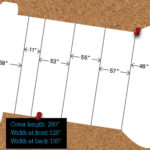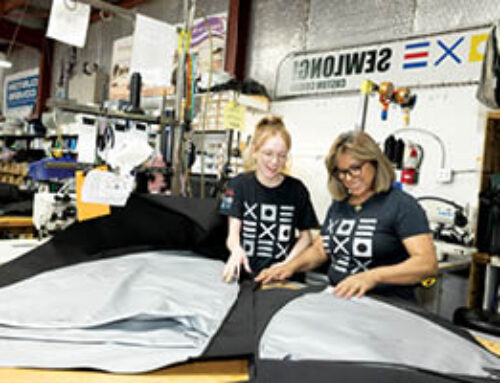Upholstery shop creates custom pontoon cover
One man takes on a pontoon cover that combines size with detailing.
The customer knew exactly what he wanted when he showed up at Bud’s Upholstery in Signal Hill, Calif., towing a well-kept 2006 Odyssey Tri-Toon.

Before
“The stock boat cover on my Odyssey is getting tired,” he said. “I’d like a new, good-looking, custom cover…you know, full coverage, tailored…” And so on and so on.
The customer and shop owner Tom Benson spent the next hour discussing the details—concerns like the fabric, the color, the changes from the original stock cover, time the job would take and, finally and most importantly, the price.
When they were agreed on most aspects of the project, Benson directed the customer to a convenient spot to park the boat. He unhitched his trailer; the two shook hands and the customer was gone. In the small parking area beside the shop at Bud’s, the Odyssey looked like the Queen Mary without the stacks. Okay, maybe that’s an exaggeration, but the Odyssey measures 24 feet in length and 8½ feet in width. Creating a custom cover for it would be no small task for one man.
The job fell to one of the top pitchers in Bud’s bullpen, young and very talented Aaron Aguirre. Benson and Aguirre had their meeting about the details of the job and how they would proceed.

After
Sunbrella was the choice for the cover, especially since its limited warranty had recently been extended from five to 10 years and other warranty features had been changed to favor the customer. Tan Sunbrella would look good on the pontoon; it would stand up to the weather and it was priced reasonably. Benson left the other details of the project to Aguirre.
His plan was to prepare sections of the fabric so he could position them horizontally across the deck of the vessel, sew them together and, in so doing, create a cover that would completely cover the length and width of the vessel’s deck (standard Sunbrella comes at 60 inches wide). He then planned to cut openings in the fabric for the primary protrusions, the ten stanchions for the two bimini sunshades.
-

- At Bud’s Upholstery in Signal Hill, Calif., this 2006 Odyssey Tri-Toon fitted with its factory boat cover awaits a new custom-made, fully tailored Sunbrella cover.
-

- Master trimmer Aaron Aguirre performs the tedious task of measuring the vessel and planning the details of the new cover. He takes careful notes of the boat’s dimensions and its special characteristics, all information essential to manufacture the new cover.
-

- So that the boarding door providing access to the deck would open with the new cover in place, a zipper will be sewn into the cover fabric.
-

- Aguirre plans the ten openings, five on each side of the deck, for the stanchions supporting the two bimini shades.
-

- In the shop, Aguirre lays the fabric out, measures it and plans the six sections he will need to fully cover the vessel. He then carefully measures the width of the fabric so that he can trim each of the six sections to the correct sizes, all different widths.
-

- He then cuts the sections to the correct lengths. Aguirre’s precise markings on each section of fabric tell the story of how the fabric was prepared for manufacturing the cover.
-

- Aguirre completes the six sections, each cut to a different size, to successfully construct the cover.
-

- The new cover is positioned over the factory cover and tied down so Aguirre can mark the locations of the new snaps and cut the openings for the bimini stanchions.
-

- Aguirre then begins to deal with the openings necessary to the five bimini stanchions on each side of the deck. After noting the exact location for each stanchions, he cuts out each opening.
-

- A close look at one of the bimini stanchions protruding through the opening Aguirre just cut for it.
-

- One bimini has six stanchions and the other has four, making a total of five stanchions showing on each side of the deck.
-

- A complete binding of black webbing topped with Sunbrella binding is sewn around the entire bottom of the cover.
-

- After marking the locations of the original snaps on the factory cover onto the new cover, Aguirre installs the male snaps into the new cover through the black webbing so that the female halves on the hull can be reused.
-

- Each opening for the bimini stanchions is cut into a ” keyhole ” configuration. The entire opening is then fortified with Sunbrella binding. Velcro is sewn in place so that the “keyhole” can be opened and closed.
-

- A heavy-duty plastic zipper is sewn into the cover to provide access to the boarding door while the cover is in place.
 TEXTILES.ORG
TEXTILES.ORG 














